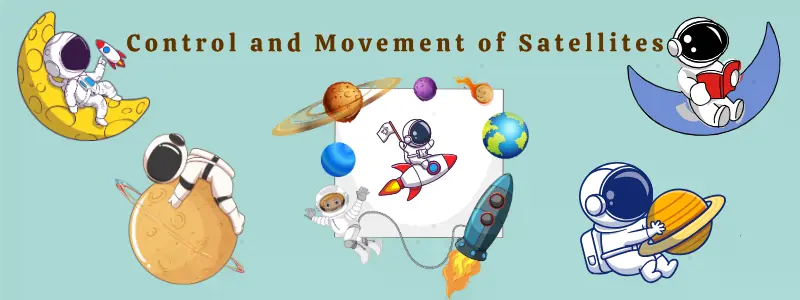Differences Between Artificial and Natural Satellites
Published: 3 Feb 2025
Satellites are objects that revolve around a planet or a star. There are two types of satellites: natural satellites, like the Moon, which form naturally, and artificial satellites, which humans create and send into space for specific purposes.

While both types orbit a celestial body, they have many differences in origin, function, and lifespan.
In this article, we will compare artificial and natural satellites in detail.
Quick Comparison Table
| Feature | Artificial Satellite | Natural Satellite |
| Definition | Man-made object orbiting a planet | Naturally occurring celestial body |
| Example | Hubble Space Telescope, GPS satellites | Moon, Titan, Europa |
| Formation | Built by scientists and launched into space | Formed naturally during planetary formation |
| Purpose | Used for communication, weather monitoring, research | Provides stability, affects tides, and supports planetary systems |
| Lifespan | Limited, usually a few years or decades | Can exist for millions or billions of years |
| Movement | Controlled by engines and commands | Moves naturally due to gravity |
| Composition | Made of metals, electronics, and solar panels | Made of rock, ice, and other natural materials |
Artificial vs Natural Satellites: Key Comparison
Let’s talk all about the differences between Artificial vs Natural Satellites in detail:
1. Definition and Origin
Artificial Satellites:
- These are human-made objects placed in orbit around planets.
- Scientists design and launch them using rockets.
- They serve different purposes like communication, research, and Earth observation.
- Examples include the Hubble Space Telescope and GPS satellites.
- Launched by space agencies like NASA, ESA, and ISRO.
Natural Satellites:
- These are celestial bodies that naturally orbit a planet or star.
- Formed from dust, gas, or debris in space over millions of years.
- Their presence affects planetary motion and tides.
- Examples include the Moon (Earth’s natural satellite) and Titan (Saturn’s moon).
- No human intervention is needed for their existence.
2. Number of Satellites
Natural Satellites:
- Limited in number, depending on the planet.
- Earth has 1 (the Moon), while Jupiter has 92.
- Usually large and noticeable.
- Found around planets and some asteroids.
- No new natural satellites can be created.

Artificial Satellites:
- Thousands orbit Earth and other planets.
- New satellites can be launched anytime.
- Some are small (CubeSats) and others are large.
- Used in space research and communication.
- Space agencies launch satellites for different tasks.
3. Purpose and Function
Artificial Satellites:
- Help in weather forecasting, GPS navigation, and internet services.
- Used for space exploration and scientific research.
- Play a key role in military surveillance and security.
- Some satellites take pictures of distant planets and galaxies.
- Others help in disaster monitoring and emergency communications.
Natural Satellites:
- Maintain the balance of a planet’s gravitational pull.
- Influence tides and climate patterns on their host planet.
- Provide stability to a planet’s rotation and orbit.
- May support the possibility of life on other planets.
- Can help scientists study planetary evolution.
4. Control and Movement
Artificial Satellites:
- Their movement is controlled by thrusters and ground commands.
- Can be placed in different orbits like geostationary and polar.
- Require adjustments to maintain position over time.
- Some satellites move in sync with Earth’s rotation.
- Can change orbit or be deorbited when no longer needed.

Natural Satellites:
- Follow natural orbital paths due to gravitational forces.
- Do not require any external control for movement.
- Orbits may change slightly over millions of years.
- Some moons are tidally locked, always showing the same side to their planet.
- Can have elliptical or circular orbits depending on their formation.
5. Lifespan and Durability
Artificial Satellites:
- Have a limited lifespan, usually ranging from a few years to decades.
- Can be damaged by space debris or technical failures.
- Some become space junk after their mission ends.
- A few are deorbited or moved to a “graveyard orbit.”
- Regular maintenance is needed for long-term missions.

Natural Satellites:
- Exist for millions or even billions of years.
- Can be affected by collisions with asteroids or comets.
- Their orbits may shift slightly over time.
- Some may eventually be pulled into their host planet or ejected into space.
- Their presence plays a crucial role in planetary evolution.
6. Composition and Structure
Natural Satellites:
- Made of natural materials like rock, ice, or gas.
- Have mountains, craters, and rough surfaces.
- Some have atmospheres, while others do not.
- Can be spherical or irregular in shape.
- Example: Saturn’s moon Titan has an atmosphere.
Artificial Satellites:
- Made of strong metals, circuits, and solar panels.
- Have antennas, sensors, and cameras for communication.
- Designed based on their purpose (weather, GPS, research).
- Can be large (Hubble Space Telescope) or small (CubeSat).
- Example: The International Space Station (ISS) is a large artificial satellite.
7. Examples and Types
Artificial Satellites:
- Communication Satellites (e.g., Starlink, Intelsat)
- Weather Satellites (e.g., GOES, Meteosat)
- Scientific Satellites (e.g., Hubble Space Telescope)
- Navigation Satellites (e.g., GPS, Galileo)
- Military Satellites (e.g., reconnaissance and spy satellites)
Natural Satellites:
- Earth’s Moon
- Mars’ Moons (Phobos and Deimos)
- Jupiter’s Moons (Io, Europa, Ganymede, Callisto)
- Saturn’s Moons (Titan, Enceladus)
- Neptune’s Moon (Triton)
8. Visibility from Earth
Natural Satellites:
- Can be seen with the naked eye (like the Moon).
- Some are visible using telescopes.
- Do not have lights but reflect sunlight.
- Their visibility depends on their distance from Earth.
- Example: Jupiter’s moons are visible with a telescope.
Artificial Satellites:
- Some are visible as moving dots in the night sky.
- Reflect sunlight but do not produce their own light.
- Can sometimes be seen just after sunset or before sunrise.
- Example: The International Space Station (ISS) is visible from Earth.
- Satellites like Starlink create bright trails in the sky.
Which is Better?
Both artificial and natural satellites play important roles:
- Artificial satellites are useful for communication, navigation, research, and Earth monitoring. They help in improving technology and space exploration.
- Natural satellites maintain the stability of planets, influence tides, and contribute to planetary evolution.

Recommendation: Natural satellites exist naturally, while artificial satellites are designed for human benefits. Each has unique purposes in space exploration and daily life.
Conclusion
Natural and artificial satellites are essential for space and daily life. Natural satellites, like the Moon, exist naturally and influence planets, while artificial satellites are designed for communication, research, and navigation.
Exploring their differences helps us appreciate their roles in science and technology.
FAQs about Natural and Artificial Satellites
Here are some of the most Frequently Asked Questions related to Artificial and Natural Satellites:
Artificial satellites are human-made and serve specific functions, while natural satellites form naturally and orbit planets.
The Moon is a natural satellite because it was formed naturally and orbits Earth.
No, artificial satellites cannot replace natural ones because natural satellites have gravitational effects on planets.
Most artificial satellites last a few years to decades before they become non-functional.
No, some planets like Mercury and Venus do not have natural satellites.
They are used for communication, weather monitoring, navigation, space research, and military purposes.
Earth’s Moon affects tides, stabilizes the planet’s rotation, and influences the climate.
Some artificial satellites use fuel for adjustments, while others rely on solar power.
It may become space debris, be deorbited, or moved to a distant orbit.
Yes, they can be hit by asteroids or eventually fall into their planet’s atmosphere.

- Be Respectful
- Stay Relevant
- Stay Positive
- True Feedback
- Encourage Discussion
- Avoid Spamming
- No Fake News
- Don't Copy-Paste
- No Personal Attacks

- Be Respectful
- Stay Relevant
- Stay Positive
- True Feedback
- Encourage Discussion
- Avoid Spamming
- No Fake News
- Don't Copy-Paste
- No Personal Attacks





